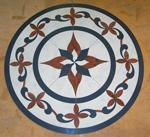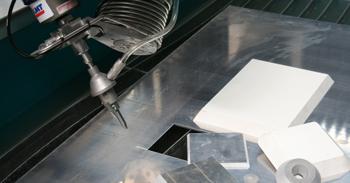National Sales Manager
- FMA
- The Fabricator
- FABTECH
- Canadian Metalworking
Categories
- Additive Manufacturing
- Aluminum Welding
- Arc Welding
- Assembly and Joining
- Automation and Robotics
- Bending and Forming
- Consumables
- Cutting and Weld Prep
- Electric Vehicles
- En Español
- Finishing
- Hydroforming
- Laser Cutting
- Laser Welding
- Machining
- Manufacturing Software
- Materials Handling
- Metals/Materials
- Oxyfuel Cutting
- Plasma Cutting
- Power Tools
- Punching and Other Holemaking
- Roll Forming
- Safety
- Sawing
- Shearing
- Shop Management
- Testing and Measuring
- Tube and Pipe Fabrication
- Tube and Pipe Production
- Waterjet Cutting
Industry Directory
Webcasts
Podcasts
FAB 40
Advertise
Subscribe
Account Login
Search
Cutting more than metal with a waterjet
Glass, stone, rubber are some of the possibilities
- By Mike Burns and Dan Davis
- December 15, 2008
- Article
- Waterjet Cutting
With waterjet cutting equipment, shops are no longer limited to the world of metal fabrications. They can search for new business in areas that were once considered unrealistic.
Simply put, a waterjet is capable of cutting almost any 2-D material, usually up to 6 to 12 inches thick, but thicker materials are possible if the operator goes slow enough. The waterjet's small-diameter cutting stream—approximately 0.040 in. to 0.050 in.—allows it to produce tight corners with very high tolerances.
Also, waterjet is a "cold" cutting process that produces no heat-affected areas or burned edges. These factors mean that there is little or no secondary operation required for most applications. Exotic materials such as titanium, Hastelloy®,andother alloysare cut easily with no need to predrill holes.
But it doesn't end there. A waterjet can cut both hard and soft materials, including titanium, stainless steel, aluminum, munitions, exotic alloys, composites, stone, marble, floor tile, glass, gasket, foam, rubber, insulation, textile, and food. The soft materials are cut with water only, while hard materials require a stream of water mixed with fine grains of abrasive garnet.
In this day when fabricating shops are looking for protection from the ups and downs of being too closely linked to one manufacturing segment, shop owners should see waterjet cutting machines as a key to diversification. These shops could be cutting glass, stone, and foam materials just as easily as cutting metals.
A Clear Understanding of Cutting Glass
Glass cutting is a suitable application for a waterjet. Without any tooling or setup changes, a fabricator can go from cutting sheet metal to cutting delicate glass. In fact, a waterjet can cut the strongest laminated, bullet-resistant glass on the market—which can be as thick as 4 in.
The very fine cutting stream enables almost any shape to be cut (see Figure 1), no matter how fine or intricate, with nearly no force from the cutting process being applied to the glass. This differs from a more traditional glass-cutting method, such as a spinning router, in which load is applied to the surface. To avoid shattering the glass, which is a real possibility, waterjet operators must use low-pressure piercing.
Glass cutting with a waterjet also can be done very fast. A waterjet is able to cut 0.25-in.-thick glass in excess of 40 inches per minute (IPM).
When cutting glass with a waterjet, an operator uses the same abrasive, mostly likely garnet, as when cutting metal. However, the operator uses less abrasive. When cutting metal, 1 lb. of abrasive is consumed; when cutting glass, 0.25 lb. to 0.50 lb. is consumed.
Like in metal cutting, the waterjet leaves a few thousandths of an inch of taper on the glass material. This is of little concern to customers because traditional cutting methods usually leave 0.50 in. of taper. The abrasive waterjet also leaves a high-quality finish, free of faults, minute fractures, and chips.
A waterjet with a five-axis cutting head can bevel and chamfer glass, which is difficult to do with traditional cutting methods.
What sort of applications might a shop cut glass for? The waterjet-cut glass commonly is used in cutouts, holes in backsplashes, frameless showers, mirrors, and other architectural applications. With a waterjet, fabricators can cut radii, contours, and profiles of any shape. It can cut an inside radius as small as 0.020 in. to 0.030 in.
The Hard Facts of Cutting Stone
A waterjet's small stream size and low-pressure piercing capability make it suitable for stone cutting as well. With extremely high pressures, up to 60,000 PSI, a waterjet stream can handle material as thick as 6 in.
The speed at which a waterjet cutting machine can cut through stone depends on the quality of cut desired and the color of the material. For example, black granite is very hard and requires a slow cutting speed, and yellow granite is less dense. A waterjet cutting machine can slice through a 1.25-in.-thick granite countertop at 5 IPM to 12 IPM and a 0.75-in.-thick backsplash at 8 IPM to 15 IPM.
Once again, garnet is the abrasive of choice for cutting stone. About the same amount of abrasive is consumed cutting stone as is used in cutting metal.
Perhaps the most important consideration for a shop looking at stone cutting is material handling. The slabs of stone are heavy, but they must be handled with care. A marred surface is not acceptable to the customer.
In addition, the slabs, which usually are 5 ft. by 6 ft. or 6 ft. by 7 ft., have to be moved in the vertical position. If they are moved around in the horizontal position, the slabs break or crack under their own weight.
That's why a shop should consider material handling upgrades when working with stone materials. Vacuum lifters can be used, but the slabs still run a great risk of cracking. Some material handling systems are specially designed to move the slabs in the vertical position and then slowly move them with hydraulic arms to the horizontal position atop the cutting bed. Maximum load capacity of such equipment is typically 1,100 lbs.
The slight taper that a waterjet cutting machine might leave is not a concern for most stone-cutting applications. Polishing usually is required anyway, but with a waterjet not as much time will be needed for secondary finishing.
Because the waterjet produces a very clean cut, a shop doesn't need to worry about grinding after the cut to get the stone to meet the exact specs. Programming software assists the waterjet cutting machine in delivering stone cut to the exact dimensions required.

Figure 2 A waterjet cutting machine and a good programming software package make cutting decorative stone inlays a simple job.
What sort of applications might a shop cut stone for? The obvious end uses can be seen all around a house—kitchen and bathroom countertops, backsplashes, flooring (see Figure 2), and landscaping accessories.
When the Rubber Hits the Waterjet
Waterjet cutting also is suitable for many foam, rubber, plastic, insulation, and woven materials, and a shop doesn't have to worry about the material handling headaches associated with surface-sensitive material such as glass and stone.
A programmer can plan for a very tight nest, and because of the waterjet's fine cutting stream, good material yields can be obtained. A waterjet can accommodate stack cutting, with a thickness up to 8 in. being possible.
The real benefit a waterjet offers for cutting these materials is speed. Multiple cutting heads combined with conveyor feed systems can achieve cutting speeds of almost 1,000 IPM.
Typically, those rubber, foam, and similar materials are cut using a steel rule die, which has to be designed and constructed for each cutting job. A waterjet replaces the need for the die, which can cost thousands of dollars.
Shops cutting plastics don't have to worry about the cutting process interacting with the material and releasing noxious fumes. The cold nature of the waterjet stream eliminates the possibility of such interactions.
Nonmetal Cutting in the Future
The cutting of nonmetals is going to increase in the future, especially as people become more aware of global trends. For instance, the use of glass as an architectural element in both commercial and residential buildings in Asia and Europe dwarfs the use in the U.S. Tinted glass is used extensively in Asia and Europe as a backsplash as opposed to stone materials.
Also, more aerospace components are being made of composite materials instead of metal. Boeing, for example, has made it known that its 787 Dreamliner will be made mostly of composite material.
A fabricator with a waterjet cutting machine can take advantage of these trends, while simultaneously cutting the metal sheet and plate that helped to build the business.
About the Authors

Dan Davis
Editor-in-Chief
2135 Point Blvd.
Elgin, IL 60123
815-227-8281
Dan Davis is editor-in-chief of The Fabricator, the industry's most widely circulated metal fabricating magazine, and its sister publications, The Tube & Pipe Journal and The Welder. He has been with the publications since April 2002.
Related Companies
subscribe now

The Fabricator is North America's leading magazine for the metal forming and fabricating industry. The magazine delivers the news, technical articles, and case histories that enable fabricators to do their jobs more efficiently. The Fabricator has served the industry since 1970.
start your free subscription- Stay connected from anywhere

Easily access valuable industry resources now with full access to the digital edition of The Fabricator.

Easily access valuable industry resources now with full access to the digital edition of The Welder.

Easily access valuable industry resources now with full access to the digital edition of The Tube and Pipe Journal.
- Podcasting
- Podcast:
- The Fabricator Podcast
- Published:
- 04/16/2024
- Running Time:
- 63:29
In this episode of The Fabricator Podcast, Caleb Chamberlain, co-founder and CEO of OSH Cut, discusses his company’s...
- Trending Articles
AI, machine learning, and the future of metal fabrication

Employee ownership: The best way to ensure engagement

Steel industry reacts to Nucor’s new weekly published HRC price

Dynamic Metal blossoms with each passing year

Metal fabrication management: A guide for new supervisors

- Industry Events
16th Annual Safety Conference
- April 30 - May 1, 2024
- Elgin,
Pipe and Tube Conference
- May 21 - 22, 2024
- Omaha, NE
World-Class Roll Forming Workshop
- June 5 - 6, 2024
- Louisville, KY
Advanced Laser Application Workshop
- June 25 - 27, 2024
- Novi, MI




























